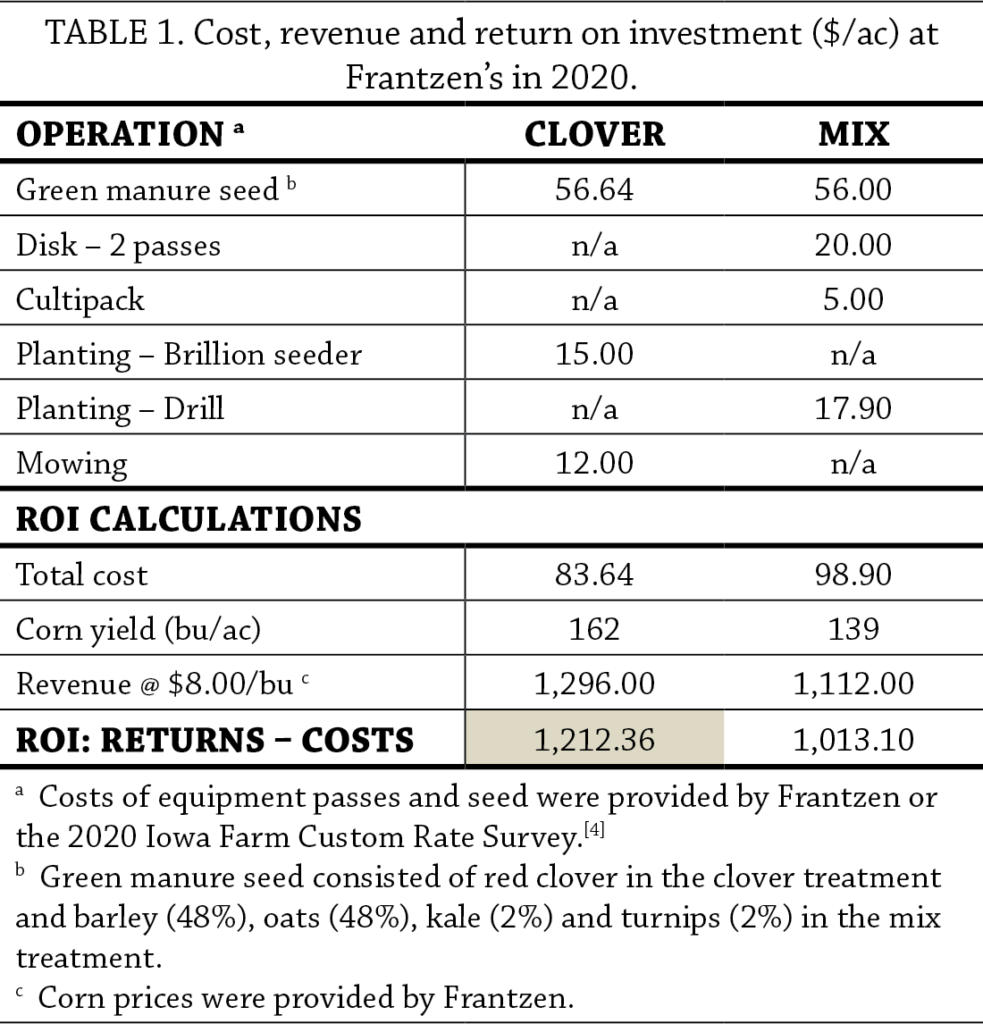Interseeded and Summer-seeded Green Manure Cover Crops for an Organic Hybrid Rye-Corn System
This research was funded by the Walton Family Foundation.
In a Nutshell:
- July harvest of Tom Frantzen’s organic hybrid rye crop affords him the opportunity to grow a nitrogen-fixing green manure between rye harvest and planting corn the subsequent spring.
- The objective of this research was to compare the effects on yield and profitability of corn preceded by red clover frost-seeded into hybrid rye and corn preceded by a cloverless green manure mix seeded after rye harvest.
Key Findings:
- Frost-seeding red clover into Frantzen’s hybrid rye crop resulted in greater corn yields and a larger return on investment than planting a cloverless mix after rye harvest.
- In addition to improving corn yield and short term return on investments with the frost-seeded red clover treatment, Frantzen saved two tillage passes – something he values for its long-term benefits to his farm’s soil ecology and structure.
Background
The July harvest of Tom Frantzen’s organic hybrid rye crop affords him the opportunity to grow a nitrogen-fixing green manure between rye harvest and planting corn the subsequent spring. Of two common green manures, Frantzen wanted to know which would be ideal for his operation. To determine this, he proposed comparing the effects of the following two treatments on yield and profitability of a subsequent corn crop in an on-farm research trial:
- Clover – hybrid rye planted in Sept. 2018; red clover frost-seeded March, 2019; corn planted in 2020
- Mix – hybrid rye planted in Sept. 2018; a mix of barley, oats, kale and turnips drilled after rye harvest in July 2019; corn planted in 2020
Frantzen hypothesized corn following the clover green manure would yield more given its longer growing period and its likelihood of generating more biomass and nitrogen. Indeed, PFI on-farm research trials conducted in 2015 and 2016 by Wade Dooley and Dick Sloan showed that interseeding clover-containing green manure mixes to an established cereal rye grain crop resulted in greater corn yields compared to seeding cloverless mixes after cereal rye grain harvest.[1,2]
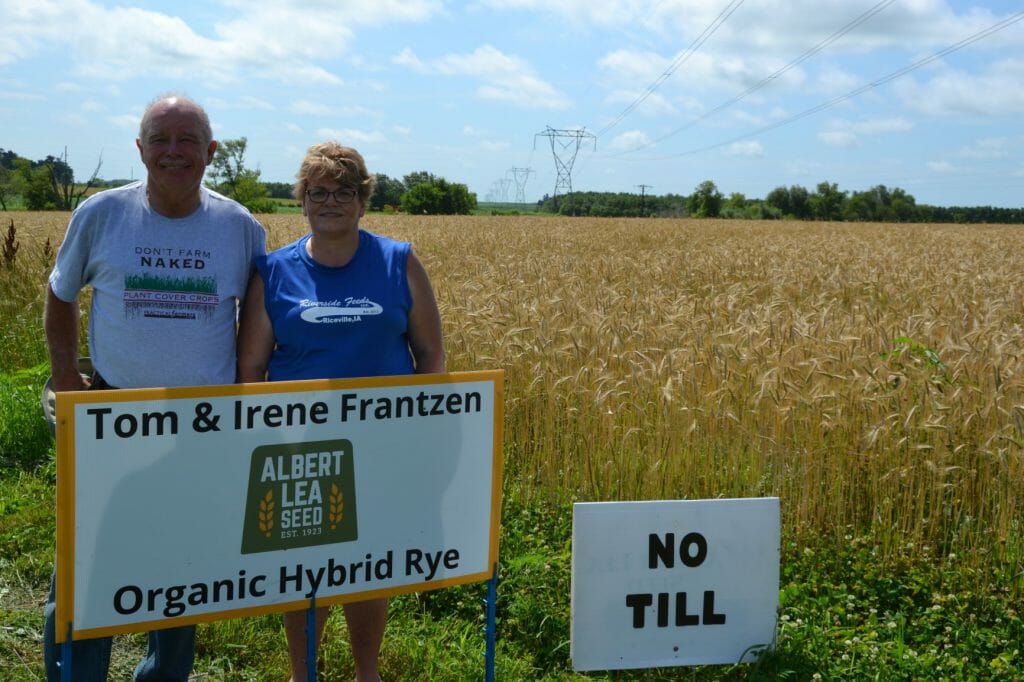
Tom and Irene Frantzen next to their organic hybrid rye. Photo taken July 15, 2019, ten days before harvest.
“No-till frost seeding [red clover] has many advantages, and if it works then tillage is reduced and the impact on soil is better,” Frantzen stated. He highlighted the value of both green manure options as late fall pasture for his beef cow herd, saying, “The viability and impact of hybrid rye will be boosted by this development. Our beef cow herd will be more economical with the late season grazing.”
Methods
Design
On Sept. 20, 2018., Frantzen no-till drilled organic hybrid rye in 8-in. rows at 725,000 seeds/ac on land that had previously been planted to a Japanese Millet bedding crop. Frantzen established treatment strips on March 31, 2019, by frost-seeding red clover (16 lb/ac) in the strips to which the clover treatment was assigned. Strips were replicated seven times and measured 24 ft wide by 330 ft long (0.18 ac). On July 25, Frantzen harvested rye, which averaged a yield of 67 bu/ac across all treatment strips. Six days later (July 31), in the strips to which the mix treatment was assigned, Frantzen disked twice, cultipacked, then drilled a mix of barley (48 lb/ac), oats (48 lb/ac), kale (2 lb/ac) and turnips (2 lb/ac) in 8-in. rows. Frantzen mowed the clover strips on Aug. 15, to prevent ragweed from going to seed then grazed livestock in both treatments beginning in October.
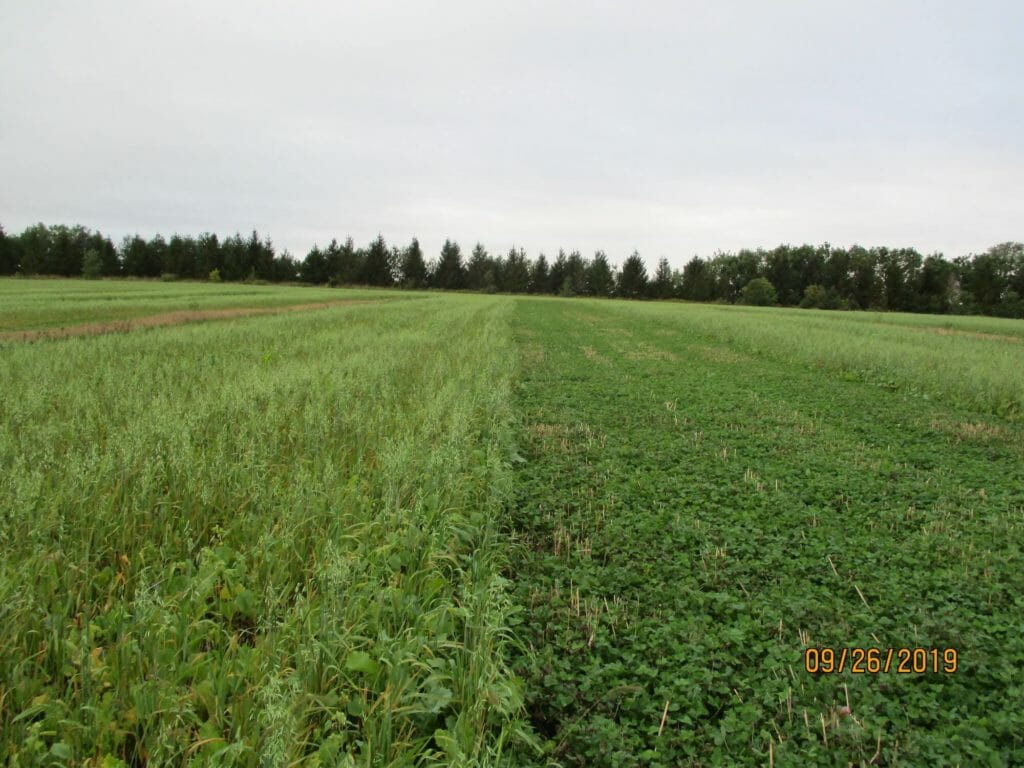
Mix treatment strip (left) and clover treatment strip (right) two months after harvesting rye but prior to grazing. Photo taken September 26, 2019.
To prepare his seedbed for planting corn, Frantzen ran a disk through all strips on Apr. 18, 2020, followed by a soil finisher on May 11. On May 22, he planted corn in 36-in. rows at a population of 33,000 seeds/ac. Subsequent weed control methods were identical in both treatments and consisted of two flame weeding events (May 29, June 29), rotary hoeing on June 1, and cultivation on June 20.
Measurements
Frantzen harvested corn and recorded yields from each individual strip on Oct. 26, 2020. Yields were adjusted to standard moisture (15.5%).
Data analysis
To evaluate the effect of green manure cover crop on corn yield and profitability, we calculated the least significant difference (LSD) at the 95% confidence level using a t-test for the corn yield measurement. If the difference in average yield between the two green manure treatments was greater than the LSD, we would expect such a difference to occur 95 times out of 100 under the same conditions – we refer to this as a statistically significant effect. On the other hand, if the difference resulting from the two green manure treatments was less than the LSD, we would consider the results to be statistically similar. We could make these statistical calculations because Frantzen’s experimental design involved replication of the two treatments (Figure A1).
Results and Discussion
Corn yield
Corn planted following red clover statistically out-yielded corn planted following the summer-seeded mix (Figure 1). These results are in alignment with Frantzen’s hypothesis and previous PFI on-farm research. Yield in both strips was below the Chickasaw county average in 2020, which was 187 bu/ac.[3]
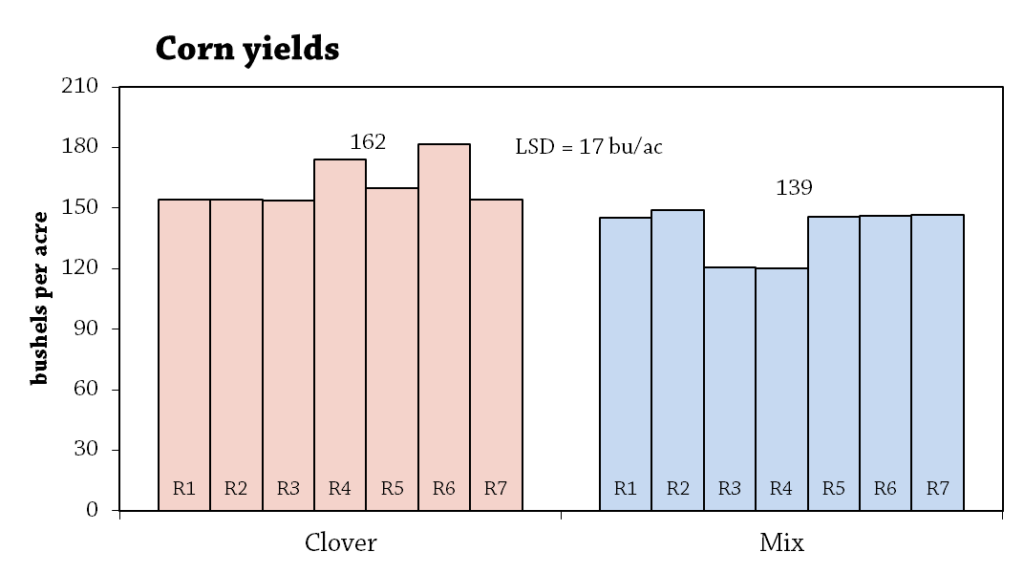
FIGURE 1. Corn yields at Tom Frantzen’s in 2020. Clustered columns represent yields of individual strips in a treatment, and the average yield of each treatment appears above the column clusters. Because the difference between the averages is greater than the least significant difference (LSD) in both experiments, the treatment yields are considered statistically different at the 95% confidence level.
Economic considerations
The return on investment was $200/ac greater in the clover treatment than in the mix treatment (Table 1). The significantly greater corn yield coupled with the lower total cost of the clover treatment translated to greater revenue.
Conclusions and Next Steps
Frost-seeding red clover into Frantzen’s hybrid rye crop resulted in greater corn yields and a larger return on investment than planting a cloverless mix after rye harvest. In Frantzen’s words, “What works is what makes money in the long and short run!” In addition to improving corn yield and short term return on investments with the frost-seeded red clover treatment, Frantzen saved two tillage passes – something he values for its long-term benefits to his farm’s soil ecology and structure.
Appendix – Trial Design and Weather Conditions

FIGURE A1. Tom Frantzen’s experimental design consists of seven replications of both treatments. This design allows for statistical analysis of the data
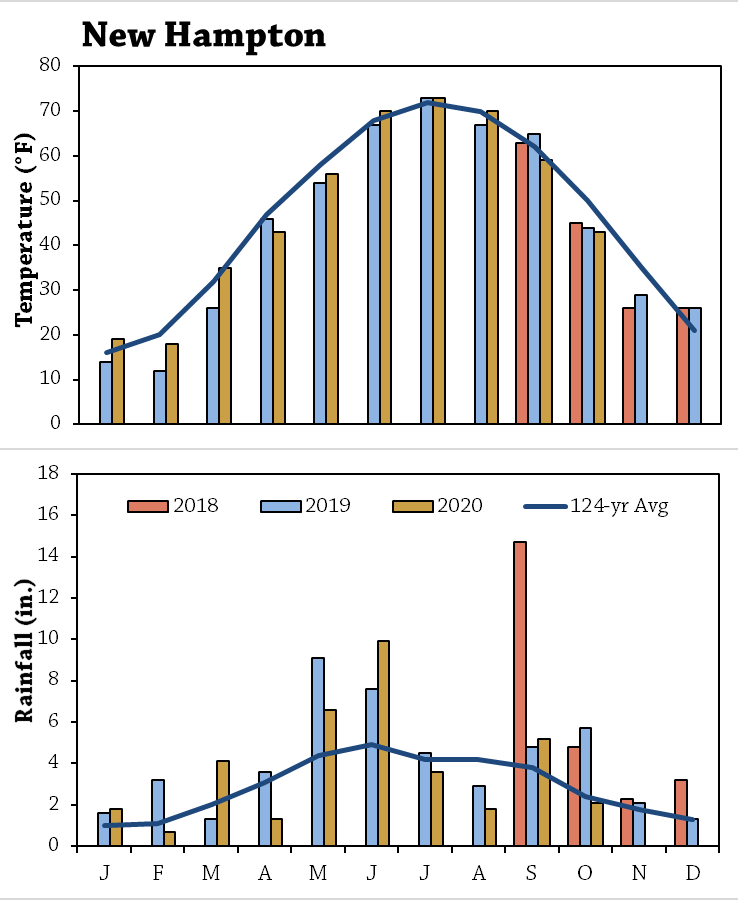
FIGURE A2. Mean monthly temperature and rainfall during the trial period and the long-term averages at New Hampton, the nearest weather station to Frantzen’s farm (about 0 miles away).[5]
References
- Gailans, S. and W. Dooley. 2016. Effect on corn of green manure cover crops established with cereal rye seed crop. Practical Farmers of Iowa Cooperators’ Program. https://practicalfarmers.org/research/effect-on-corn-of-green-manure-cover-crops-established-with-cereal-rye-seed-crop/ (accessed May 2021).
- Gailans, S. and D. Sloan. 2015. Corn Following Green Manure Cover Crops Established with Small Grain. Practical Farmers of Iowa Cooperators’ Program. https://practicalfarmers.org/research/corn-following-green-manure-cover-crops-established-with-small-grain/ (accessed May 2021).
- Johanns, A. 2021. Historical Corn Yields by County in Iowa. Ag Decision Maker. Iowa State University Extension and Outreach. https://www.extension.iastate.edu/agdm/crops/html/a1-12.html (accessed April 2021).
- Plastina, A., A. Johanns and O. Massman. 2020. 2020 Iowa Farm Custom Rate Survey. FM1 1698. Ag Decision Maker. Iowa State University Extension and Outreach. https://www.extension.iastate.edu/agdm/crops/html/a3-10.html (accessed March 2021).
- Iowa Environmental Mesonet. 2021. IEM “Climodat” Reports. Iowa State University Department of Agronomy. https://mesonet.agron.iastate.edu/climodat/ (accessed March 2021).


